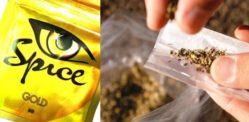If you are thinking of getting a tattoo, be sure to find out what ingredients are in the henna.
Tattoos play an important part in social and cultural lifestyles, and can even be something of a fashion statement for many people. Many Brits, especially Asians opt for henna tattoos for a trendy non-permanent option to express themselves.
But when it comes to these types of tattoos, do we really know what it is we’re putting onto our skin? While there are so many differing types of henna out there, some may be more of a risk than they are worth.
So where does natural henna actually come from? Henna originates from a plant called Lawsonia Inermis. This is ground and made into a paste which can be applied to the hair but more commonly in intricate patterns of henna, or mehndi, on the skin.
Following application, the henna is left for a few hours to dry and by the next day the colour is glowing and beautiful. After a few weeks the henna fades, especially when the user comes into contact with water regularly.
Henna is extremely popular within Asian communities, especially for festivals and weddings, as they allow beautiful temporary designs, which may brides love to adorn themselves with. With different designs for different occasions, henna allows the wearer to change the patterns whenever they want unlike the painful permanent option.

Black Henna is very popular in tourist areas abroad. The biggest misconception surrounding black henna is that it is a natural form of henna. In fact, it cannot really be described as henna at all. Most black henna consists of other harmful substances that can leave permanent lasting damage on your skin.
Black henna contains an additive called paraphenylenediamine, or PPD for short. PPD is a toxic substance which contains a compound that is derived from phenylenediamine and is extremely dangerous.
PPD when mixed into henna is what turns the henna black and many people can suffer allergic reactions from applying this to the hair let alone the skin.
With such severe chemicals used in back henna, it is no wonder that reactions are so severe, with many people forced to seek medical advice. Cleveland Clinics, an online medical site said:
“The food and drug administration is warning us of the potential danger of temporary henna tattoos. The director of the FDA’s office of cosmetics and colours say people are reporting bad reactions to the ink. Including redness and blisters.”
Dr Jennifer Lucas is a dermatologist at Cleveland Clinic who spoke about why these bad reactions occur:
“Henna tattoos by themselves aren’t necessarily the problem; it’s when they add other components to it to make them darker or to make them react more quickly.”

“Personally I don’t use ammonia on my clients. Most of the clients are unaware of the side effects. I can only advise you don’t use black henna When natural henna is very dark, it doesn’t have side effects and stays longer, there is no need to use ammonia or black henna.”
But not everyone suffers a reaction to ammonia. Navneet Kaur speaks about her experience with black henna:
“I have had three black tattoos abroad and never had any problems. I had black Indian designs on my hand which lasted two weeks; I then had a flower design on my back and butterfly design on my foot which also lasted two weeks,” she says.
Sophie Alexandra, however, was not so lucky. She explains: “I had a snake shaped design on my arm – NEVER again, I warn people to stay away from it. It sunk into my skin leaving a red rash in the design of the snake. I would advise people to stay away from it.”
Nisha Patel says: “When I went abroad a lady came over to me on the beach and asked me if I would like a henna tattoo. I thought why not, but as she started applying it, it seemed a lot darker than the henna I usually wear. I thought wow this will stand out, thinking nothing of it. This decision turned into a nightmare.”

If you are thinking of getting a tattoo, please be sure to find out what ingredients are in the henna. Black henna is often being used in the place of natural henna and marketed in this way, but black henna is mixed with other harmful ingredients.
Henna is not supposed to be black. Be cautious, especially when going abroad. Although one out of the three people we interviewed did not have any problems with the tattoo, it depends on how you as an individual react towards certain ingredients.




























































